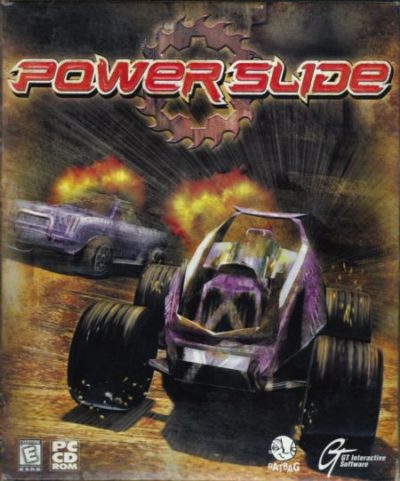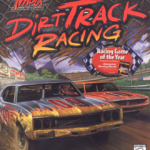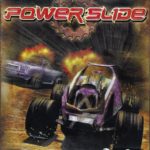
Australia has a long history of car culture – from Holden vs Ford to V8 Supercars to the Touring Car Championship and more, racing and classic car manufacturers have long been seen as a part of Australia’s cultural fabric. Through the late 90s and early 2000s, this culture became entwined with racing videogames through various avenues, ranging from Australian vehicles and tracks becoming staples in international racing game franchises like Need for Speed and TOCA, to racing games designed and rebranded to appeal to an exclusively Australian audiences. The same can be said for the output of Australian developers like Melbourne House, Tantalus, Torus and more who output racing titles internationally like Dethkarz, GP 500, South Park Rally, Carmageddon TDR 2000, Grand Prix Challenge and more.
It was around this same period that an Australian studio was formed who would make racing games their bread and butter. Founded in Adelaide in 1993 as Emergent Games by friends Richard Harrison and Greg Siegele, but later changed to Ratbag Games, the studio would endure various successes and failures across the years emblematic of the challenges facing developers, particularly in Australia. From 1998 to 2004, the studio released eight games, all racers, that ran the gamut from cult hits like Powerslide to a series of successful and iterative sequels in the Dirt Track Racing series to an adaptation of television show The Dukes of Hazzard, before being bought up and closed amidst industry changes.
Harrison and Siegele were originally interested in making both VR games and hardware, a move Siegele later referred to as “ambitious for a couple of 25-year-olds with no experiences and no connections.”[1] This ambition was shelved when Sony and Nintendo announced their move into 3D graphics, leading to Harrison and Siegele to instead decide to make a game for PC Windows called Powerslide that drew from the duo’s love of racing games, especially Stunt Car Racer from 1989.
The studio took three years and all the founders’ personal savings to develop the engine that would create Powerslide. Over the Australian summer of 1996–1997, with a team assembled from artists and programmers still at university, a Powerslide prototype was finally put together. With no safety net and three years of work behind them, Harrison and Siegele flew to the United States to present the demo at E3 in Atlanta, Georgia in May of 1997. The game boasted a smooth 60 frames and 250,000 polygons per second, making it, according to Siegele, “the first time that arcade quality 3D graphics had been seen on a home machine, and predictably the publishers we showed it to went nuts.” Emergent’s phone began “ringing off the hook” from potential publishers.[2] They eventually settled on GT Interactive due to their frontrunner status as a PC publisher, having previously published games like Doom, Duke Nukem 3D and Quake.
The issue now became making the game. Changing their name from Emergent to Ratbag Games, the studio only consisted of seven people at the time, none of which had actual experience making a game, and five of which who were still at university. The “vapourware studio from hell,” in Sigele’s words, spent seven months negotiating with GT while on the edge of bankruptcy before eventually managing to squeeze out AU$2 million to hire ten more employees and get started on official development in January of 1998. “It was then ten months of flat-out development carnage and sleeping bags in the office. Everyone working on that game gave their lives to it for ten months.”
Powerslide was eventually released in 1998 as a post-apocalyptic Mad Max-inspired car racing title set in a dystopian future where the ozone layer has disintegrated, the rich have retreated underground and those left on the surface race for entertainment and fresh fruit. Tracks were open with no invisible walls, meaning players could explore to find faster routes and short cuts. It also contained an online multiplayer mode and was reportedly the first non-arcade 3D game to run at a smooth 60 frames per second. Its physics engine allowed for four-wheel independent suspension, allowing the game to realistically depict its namesake, powersliding.
The game was a critical success, with IGN awarding it racing game of the year for 1998.[3] Financially, the news was more mixed. It sold well in Europe but was hampered in North America by corporate politics at publisher GT Interactive. At the same time they were publishing Powerslide, GT had another game called TransAm Racing in the works from another start-up studio that the VP of marketing worried Powerslide would hurt the sales of. Despite TransAm eventually being cancelled after a laboured development process, GT printed only 7,000 copies of Powerslide in North America, essentially guaranteeing its failure.
Despite this, the game’s critical success and financial success in Europe led to GT initially being eager for another title, offering a quadrupled budget of AU$8 million to make it happen. However, this funding never materialised due to GT’s own financial struggles, leading to them pulling out as publisher and being bought out by Infrogrames Inc. in 1999. The loss of their publisher and funding led to Ratbag burning through their Powerslide profit on preproduction for a game that was never released. Ratbag was once again close to bankruptcy. Siegele said the studio only continued to exist based on the staff agreeing to a pay cut in exchange for 40% of the advance and royalties from future games.
Fortunately the next game Ratbag released, Dirt Track Racing in 1999, was a big hit and the studio recovered. The idea for the game emerged from Powerslide’s most popular online track, a dirt track called Speedway, with Ratbag correctly presuming there would be an audience for a game based entirely around that type of racing. Dirt Track Racing was made with the same engine as Powerslide and contained the same selection of modes, with the addition of an early example of a racing career mode. It sees the player start as an amateur with a thousand dollars to their name who must work their way through various championships to earn more and upgrade their car. This mode also meant car collisions had consequences, where earned money had to be spent to repair the car between races. An Australian-exclusive version of the game creatively titled Dirt Track Racing: Australia was also released containing six additional Holden muscle cars.
Developing the game led to publisher Wizardworks Software, a subsidiary of GT Interactive, seeing the potential market for the game and approaching Ratbag Games. Their assumption proved correct with Dirt Track Racing selling well and being followed by Dirt Track Racing: Sprint Cars in 2000, a spin-off called Leadfoot: Stadium Off-Road Racing in 2001 and Dirt Track Racing 2 in 2002. Each title added something different to the series, with Sprint Cars adding twenty new tracks and an updated physics model alongside its new car type, Leadfoot focusing on short-track stadium truck racing and Dirt Track Racing 2 upgrading the graphics and car models.
After Dirt Track Racing, the studio began to branch out into both different titles and platforms. 2002 and 2004 saw the release of World of Outlaws: Sprint Cars 2002 and Saturday Night Speedway respectively on both PC and PlayStation 2. According to Siegele the transition from PC to console was difficult, with the studio taking so long to adapt the engine to the PlayStation that a publishing contract with Sony for two titles fell through. After the success of the Dirt Track Racing series the studio had grown to 70 people, but this failure led to 21 employees being let go. Eventually Infrogrames, the same company who had bought up original publisher GT Interactive, picked up the publishing rights for World of Outlaws[4] and Atari Inc. ended up publishing Saturday Night Speedway.
Ratbag’s next game would be The Dukes of Hazzard: Return of the General Lee, released in 2004 to coincide with the film adaptation a year later. It connected to the plot of the original television series of the same name and follows the Duke cousins, voiced by their original actors, paying off the debt on their foster home. This was the first Ratbag game to offer a free roam feature that allowed the player to drive across Hazzard County. There was reportedly a minor controversy prior to the game’s release centred around the titular car the ‘General Lee,’ in how it is named after confederate general Robert E. Lee and bears a confederate flag on its roof. Early screenshots appeared to suggest the flag was absent from the game, only for it to be present in the game’s final release. The series’ conflation with the flag would later see reruns of the show being removed from the air in 2015, as well as Warner Bros. removing the flag from toy cars based on the character.[5]
The game was not critically well received,[6] but Ratbag had already moved on to developing a game for Midway as well as a sequel to their original game titled Powerslide: Slipstream. A prototype developed for the PlayStation 2 was set on a post-apocalyptic Sydney Harbour track that had the Sydney Harbour Bridge and Luna Park looking over the start/finish line.[7] They were also working on a music game with Adelaide company Starplayit that used real guitars as the controllers. However, they struggled to find a publisher for both that game and Slipstream due to an apparent lack of interest in music and post-apocalyptic games. This would change in subsequent years, with the first Guitar Hero and Fallout 3 being released in 2005 and 2008 respectively to widespread success.
In 2005, owners of Ratbag Siegele and Harrison had decided to find a buyer for the company. Siegele cited 2005 as a “transition time for the industry,” where everyone was moving to the PlayStation 3 and Xbox 360 and “budgets for these platforms were north of US$10 million and independent developers like Ratbag were not getting contracts.” Enter Midway, who Ratbag was currently working on a game with, and who was so impressed by how development was progressing that they made Ratbag an offer that Siegele and Harrison accepted.
The acquisition officially went through on the 4th of August 2005 to the tune of US$5.7 million worth of Midway shares[8] and changing the studio’s name from ‘Ratbag Games’ to ‘Midway Studios – Australia.’ Midway’s CEO David F. Zucker commented at the time that “Ratbag brings to Midway a rare combination of development expertise in driving and on-foot combat that they are incorporating into our games now in development.” However, none of these games were ever released. Less than 5 months after the acquisition, twelve days before Christmas, employees at the studio were told Midway Australia was going to shut its doors. Two days later, every staff member was officially unemployed.
Per Greg Siegele, “the closure of our studio was brutal. It is devastating to have something you have spent twelve years building trashed in two days.” 75 staff lost their jobs. Thankfully, Ratbag had a good enough reputation that in the week following “companies flew in from around Australia and overseas to interview our staff, and within two weeks almost everyone had multiple job offers.” Brisbane developer Krome Studios rehired enough of the staff to form a new studio called Krome Studios Adelaide.[9]
Ratbag Games operated for twelve years from 1993 to 2005 and released 8 games, all of them racing titles. Despite the lack of experience of its founders to the constant financial challenges and falling outs with publishers, the studio saw a brief stint of financial and critical success. Also relevant to Ratbag’s legacy is not only its slew of racing games, but the many projects that never saw the light of day, ranging from a sequel to Powerslide to a Guitar Hero game before Guitar Hero. Regardless, they remain a developer who was tied intimately with Australia’s culture of cars and racing, as well as a story of success and struggle in the Australian videogame development scene.
– Cass Barkman
[1]All Greg Siegele quotes in this post, unless otherwise stated, come from the following source: https://www.pcworld.idg.com.au/article/416283/powerslide_interview_ratbag_games_ceo_greg_siegele/
[2] Next Generation Issue 35, Nov 1997, p. 137
[3] https://www.ign.com/articles/1999/01/29/ignpcs-best-of-1998-awards
[4] They had also purchased fellow Australian developer Melbourne House several years prior.
[5] https://ew.com/tv/dukes-of-hazzard-confederate-car/
[6] https://www.ign.com/articles/2004/10/06/the-dukes-of-hazzard-return-of-the-general-lee
[7] https://www.ign.com/articles/2015/05/20/the-post-apocalyptic-racer-that-went-extinct-too-early
[8] https://www.gamasutra.com/php-bin/news_index.php?story=6120
[9] https://www.smh.com.au/technology/the-fall-of-the-great-australian-video-games-studio-20150424-1mshm2.html
Company Meta
Other Names
Images
Media
Video



